Developing Teaching, Learning, and Assessment in Education and Training
VerifiedAdded on 2022/12/14
|17
|5241
|82
AI Summary
This report discusses the importance of behavior management in the classroom, including definitions, principles, and theories. It also explores the role of communication in teaching and learning.
Contribute Materials
Your contribution can guide someone’s learning journey. Share your
documents today.
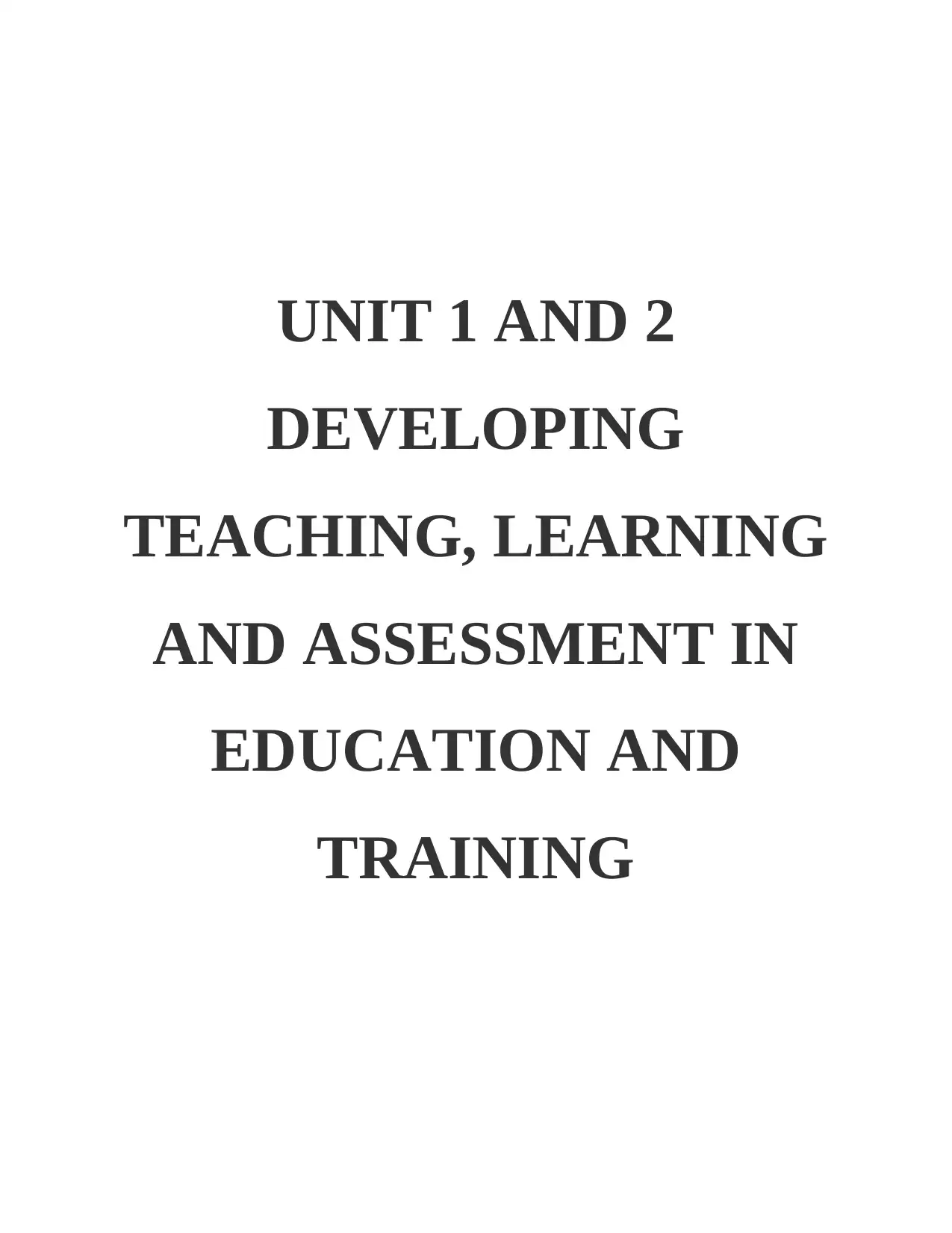
UNIT 1 AND 2
DEVELOPING
TEACHING, LEARNING
AND ASSESSMENT IN
EDUCATION AND
TRAINING
DEVELOPING
TEACHING, LEARNING
AND ASSESSMENT IN
EDUCATION AND
TRAINING
Secure Best Marks with AI Grader
Need help grading? Try our AI Grader for instant feedback on your assignments.
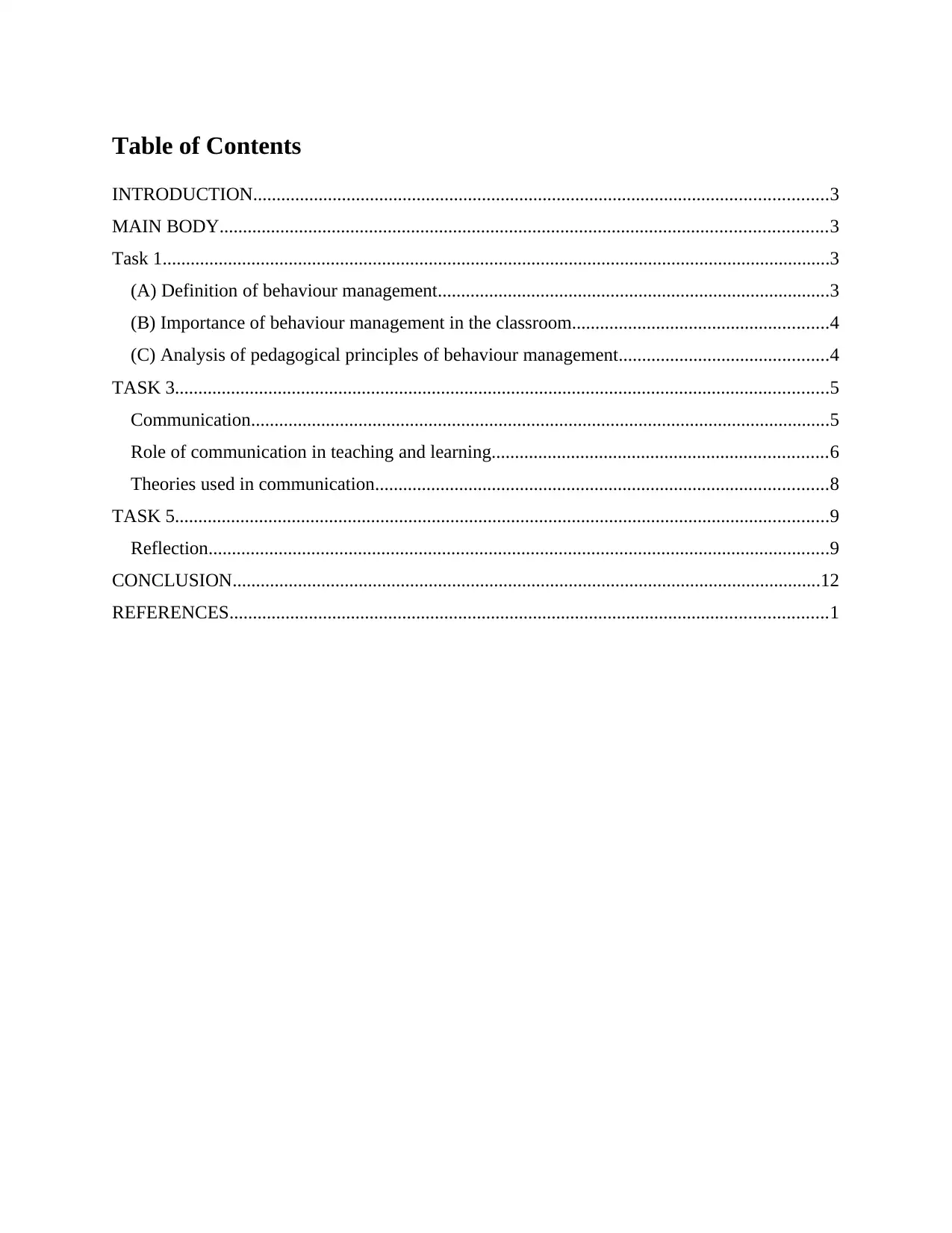
Table of Contents
INTRODUCTION...........................................................................................................................3
MAIN BODY..................................................................................................................................3
Task 1...............................................................................................................................................3
(A) Definition of behaviour management....................................................................................3
(B) Importance of behaviour management in the classroom.......................................................4
(C) Analysis of pedagogical principles of behaviour management.............................................4
TASK 3............................................................................................................................................5
Communication............................................................................................................................5
Role of communication in teaching and learning........................................................................6
Theories used in communication.................................................................................................8
TASK 5............................................................................................................................................9
Reflection.....................................................................................................................................9
CONCLUSION..............................................................................................................................12
REFERENCES................................................................................................................................1
INTRODUCTION...........................................................................................................................3
MAIN BODY..................................................................................................................................3
Task 1...............................................................................................................................................3
(A) Definition of behaviour management....................................................................................3
(B) Importance of behaviour management in the classroom.......................................................4
(C) Analysis of pedagogical principles of behaviour management.............................................4
TASK 3............................................................................................................................................5
Communication............................................................................................................................5
Role of communication in teaching and learning........................................................................6
Theories used in communication.................................................................................................8
TASK 5............................................................................................................................................9
Reflection.....................................................................................................................................9
CONCLUSION..............................................................................................................................12
REFERENCES................................................................................................................................1
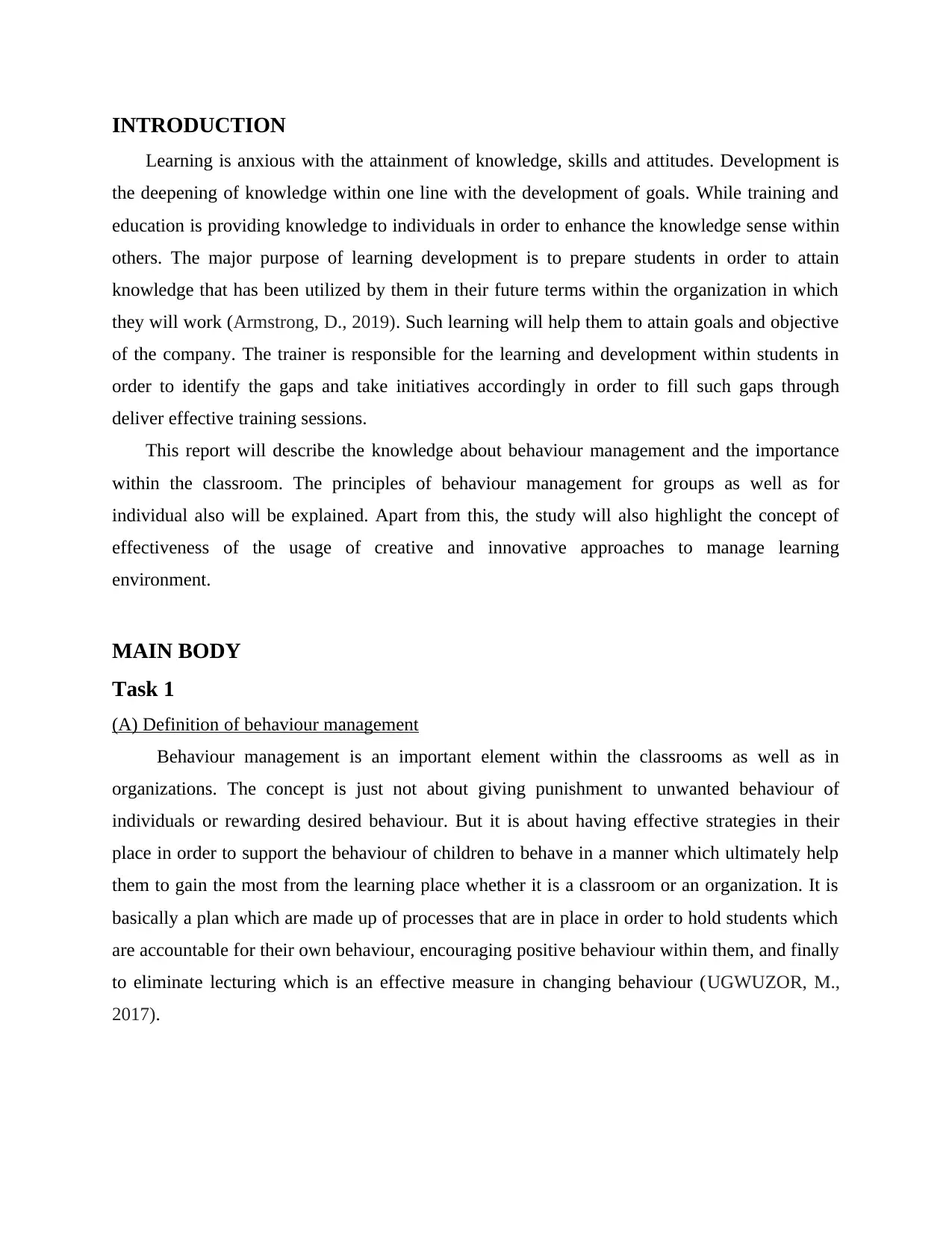
INTRODUCTION
Learning is anxious with the attainment of knowledge, skills and attitudes. Development is
the deepening of knowledge within one line with the development of goals. While training and
education is providing knowledge to individuals in order to enhance the knowledge sense within
others. The major purpose of learning development is to prepare students in order to attain
knowledge that has been utilized by them in their future terms within the organization in which
they will work (Armstrong, D., 2019). Such learning will help them to attain goals and objective
of the company. The trainer is responsible for the learning and development within students in
order to identify the gaps and take initiatives accordingly in order to fill such gaps through
deliver effective training sessions.
This report will describe the knowledge about behaviour management and the importance
within the classroom. The principles of behaviour management for groups as well as for
individual also will be explained. Apart from this, the study will also highlight the concept of
effectiveness of the usage of creative and innovative approaches to manage learning
environment.
MAIN BODY
Task 1
(A) Definition of behaviour management
Behaviour management is an important element within the classrooms as well as in
organizations. The concept is just not about giving punishment to unwanted behaviour of
individuals or rewarding desired behaviour. But it is about having effective strategies in their
place in order to support the behaviour of children to behave in a manner which ultimately help
them to gain the most from the learning place whether it is a classroom or an organization. It is
basically a plan which are made up of processes that are in place in order to hold students which
are accountable for their own behaviour, encouraging positive behaviour within them, and finally
to eliminate lecturing which is an effective measure in changing behaviour (UGWUZOR, M.,
2017).
Learning is anxious with the attainment of knowledge, skills and attitudes. Development is
the deepening of knowledge within one line with the development of goals. While training and
education is providing knowledge to individuals in order to enhance the knowledge sense within
others. The major purpose of learning development is to prepare students in order to attain
knowledge that has been utilized by them in their future terms within the organization in which
they will work (Armstrong, D., 2019). Such learning will help them to attain goals and objective
of the company. The trainer is responsible for the learning and development within students in
order to identify the gaps and take initiatives accordingly in order to fill such gaps through
deliver effective training sessions.
This report will describe the knowledge about behaviour management and the importance
within the classroom. The principles of behaviour management for groups as well as for
individual also will be explained. Apart from this, the study will also highlight the concept of
effectiveness of the usage of creative and innovative approaches to manage learning
environment.
MAIN BODY
Task 1
(A) Definition of behaviour management
Behaviour management is an important element within the classrooms as well as in
organizations. The concept is just not about giving punishment to unwanted behaviour of
individuals or rewarding desired behaviour. But it is about having effective strategies in their
place in order to support the behaviour of children to behave in a manner which ultimately help
them to gain the most from the learning place whether it is a classroom or an organization. It is
basically a plan which are made up of processes that are in place in order to hold students which
are accountable for their own behaviour, encouraging positive behaviour within them, and finally
to eliminate lecturing which is an effective measure in changing behaviour (UGWUZOR, M.,
2017).
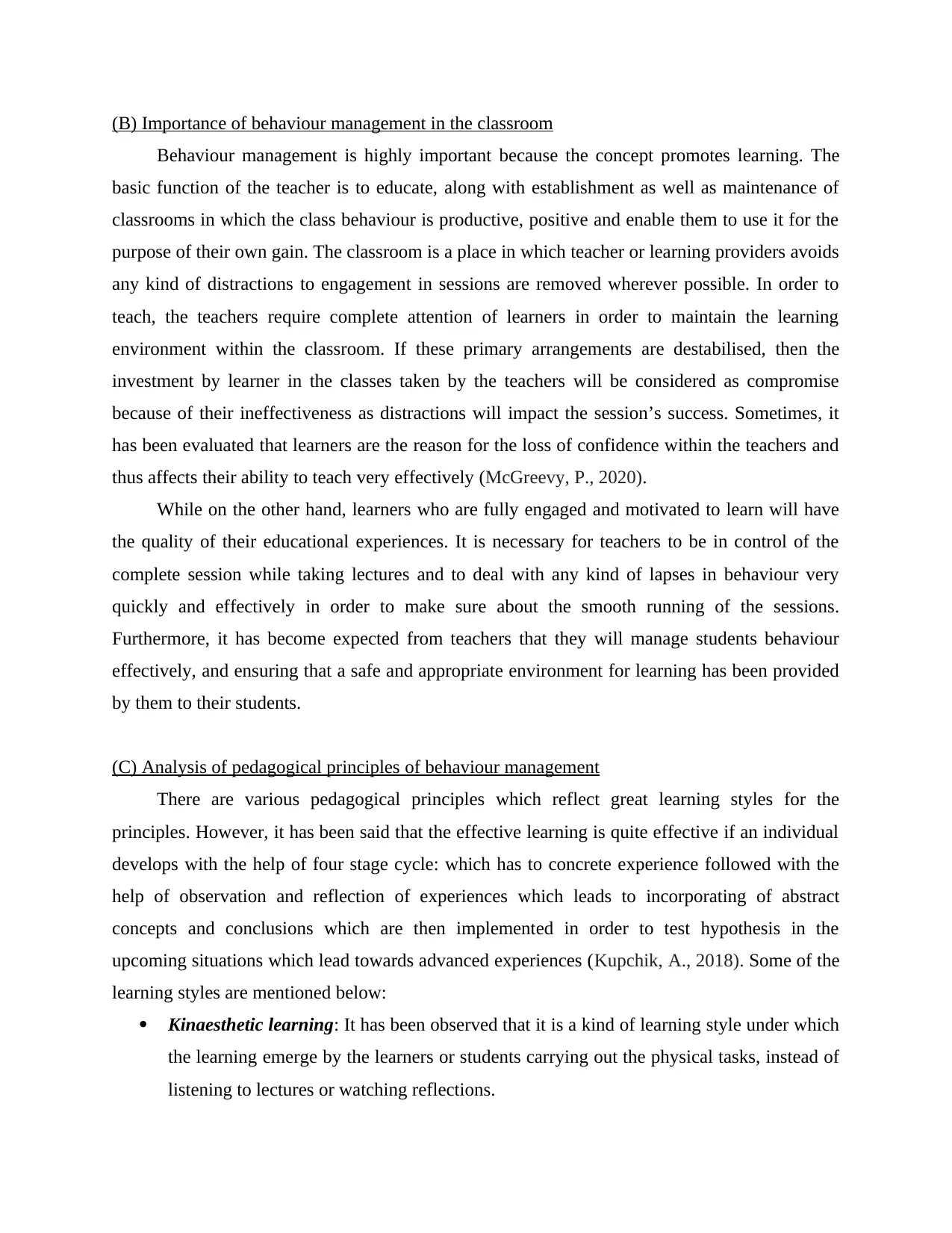
(B) Importance of behaviour management in the classroom
Behaviour management is highly important because the concept promotes learning. The
basic function of the teacher is to educate, along with establishment as well as maintenance of
classrooms in which the class behaviour is productive, positive and enable them to use it for the
purpose of their own gain. The classroom is a place in which teacher or learning providers avoids
any kind of distractions to engagement in sessions are removed wherever possible. In order to
teach, the teachers require complete attention of learners in order to maintain the learning
environment within the classroom. If these primary arrangements are destabilised, then the
investment by learner in the classes taken by the teachers will be considered as compromise
because of their ineffectiveness as distractions will impact the session’s success. Sometimes, it
has been evaluated that learners are the reason for the loss of confidence within the teachers and
thus affects their ability to teach very effectively (McGreevy, P., 2020).
While on the other hand, learners who are fully engaged and motivated to learn will have
the quality of their educational experiences. It is necessary for teachers to be in control of the
complete session while taking lectures and to deal with any kind of lapses in behaviour very
quickly and effectively in order to make sure about the smooth running of the sessions.
Furthermore, it has become expected from teachers that they will manage students behaviour
effectively, and ensuring that a safe and appropriate environment for learning has been provided
by them to their students.
(C) Analysis of pedagogical principles of behaviour management
There are various pedagogical principles which reflect great learning styles for the
principles. However, it has been said that the effective learning is quite effective if an individual
develops with the help of four stage cycle: which has to concrete experience followed with the
help of observation and reflection of experiences which leads to incorporating of abstract
concepts and conclusions which are then implemented in order to test hypothesis in the
upcoming situations which lead towards advanced experiences (Kupchik, A., 2018). Some of the
learning styles are mentioned below:
Kinaesthetic learning: It has been observed that it is a kind of learning style under which
the learning emerge by the learners or students carrying out the physical tasks, instead of
listening to lectures or watching reflections.
Behaviour management is highly important because the concept promotes learning. The
basic function of the teacher is to educate, along with establishment as well as maintenance of
classrooms in which the class behaviour is productive, positive and enable them to use it for the
purpose of their own gain. The classroom is a place in which teacher or learning providers avoids
any kind of distractions to engagement in sessions are removed wherever possible. In order to
teach, the teachers require complete attention of learners in order to maintain the learning
environment within the classroom. If these primary arrangements are destabilised, then the
investment by learner in the classes taken by the teachers will be considered as compromise
because of their ineffectiveness as distractions will impact the session’s success. Sometimes, it
has been evaluated that learners are the reason for the loss of confidence within the teachers and
thus affects their ability to teach very effectively (McGreevy, P., 2020).
While on the other hand, learners who are fully engaged and motivated to learn will have
the quality of their educational experiences. It is necessary for teachers to be in control of the
complete session while taking lectures and to deal with any kind of lapses in behaviour very
quickly and effectively in order to make sure about the smooth running of the sessions.
Furthermore, it has become expected from teachers that they will manage students behaviour
effectively, and ensuring that a safe and appropriate environment for learning has been provided
by them to their students.
(C) Analysis of pedagogical principles of behaviour management
There are various pedagogical principles which reflect great learning styles for the
principles. However, it has been said that the effective learning is quite effective if an individual
develops with the help of four stage cycle: which has to concrete experience followed with the
help of observation and reflection of experiences which leads to incorporating of abstract
concepts and conclusions which are then implemented in order to test hypothesis in the
upcoming situations which lead towards advanced experiences (Kupchik, A., 2018). Some of the
learning styles are mentioned below:
Kinaesthetic learning: It has been observed that it is a kind of learning style under which
the learning emerge by the learners or students carrying out the physical tasks, instead of
listening to lectures or watching reflections.
Secure Best Marks with AI Grader
Need help grading? Try our AI Grader for instant feedback on your assignments.
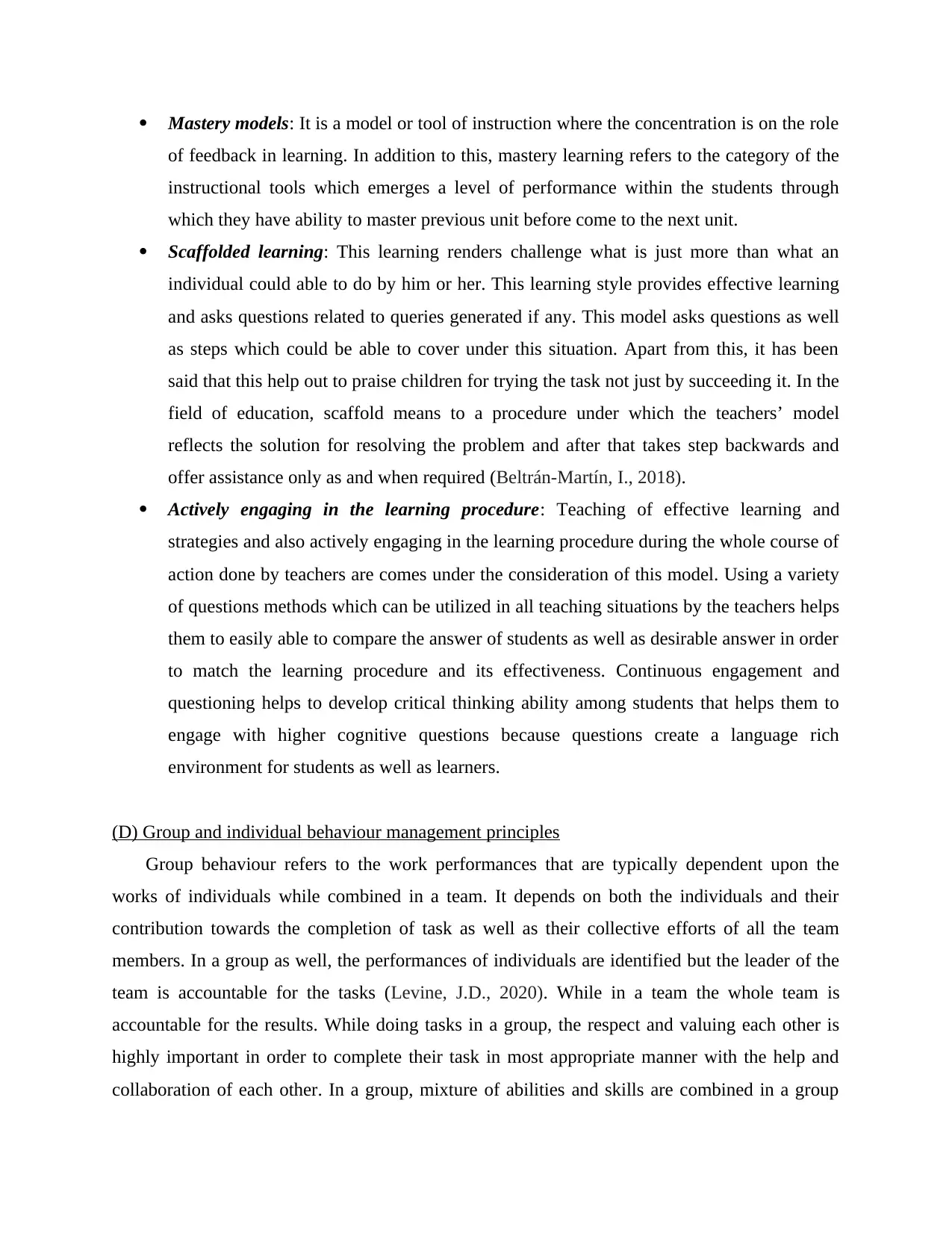
Mastery models: It is a model or tool of instruction where the concentration is on the role
of feedback in learning. In addition to this, mastery learning refers to the category of the
instructional tools which emerges a level of performance within the students through
which they have ability to master previous unit before come to the next unit.
Scaffolded learning: This learning renders challenge what is just more than what an
individual could able to do by him or her. This learning style provides effective learning
and asks questions related to queries generated if any. This model asks questions as well
as steps which could be able to cover under this situation. Apart from this, it has been
said that this help out to praise children for trying the task not just by succeeding it. In the
field of education, scaffold means to a procedure under which the teachers’ model
reflects the solution for resolving the problem and after that takes step backwards and
offer assistance only as and when required (Beltrán-Martín, I., 2018).
Actively engaging in the learning procedure: Teaching of effective learning and
strategies and also actively engaging in the learning procedure during the whole course of
action done by teachers are comes under the consideration of this model. Using a variety
of questions methods which can be utilized in all teaching situations by the teachers helps
them to easily able to compare the answer of students as well as desirable answer in order
to match the learning procedure and its effectiveness. Continuous engagement and
questioning helps to develop critical thinking ability among students that helps them to
engage with higher cognitive questions because questions create a language rich
environment for students as well as learners.
(D) Group and individual behaviour management principles
Group behaviour refers to the work performances that are typically dependent upon the
works of individuals while combined in a team. It depends on both the individuals and their
contribution towards the completion of task as well as their collective efforts of all the team
members. In a group as well, the performances of individuals are identified but the leader of the
team is accountable for the tasks (Levine, J.D., 2020). While in a team the whole team is
accountable for the results. While doing tasks in a group, the respect and valuing each other is
highly important in order to complete their task in most appropriate manner with the help and
collaboration of each other. In a group, mixture of abilities and skills are combined in a group
of feedback in learning. In addition to this, mastery learning refers to the category of the
instructional tools which emerges a level of performance within the students through
which they have ability to master previous unit before come to the next unit.
Scaffolded learning: This learning renders challenge what is just more than what an
individual could able to do by him or her. This learning style provides effective learning
and asks questions related to queries generated if any. This model asks questions as well
as steps which could be able to cover under this situation. Apart from this, it has been
said that this help out to praise children for trying the task not just by succeeding it. In the
field of education, scaffold means to a procedure under which the teachers’ model
reflects the solution for resolving the problem and after that takes step backwards and
offer assistance only as and when required (Beltrán-Martín, I., 2018).
Actively engaging in the learning procedure: Teaching of effective learning and
strategies and also actively engaging in the learning procedure during the whole course of
action done by teachers are comes under the consideration of this model. Using a variety
of questions methods which can be utilized in all teaching situations by the teachers helps
them to easily able to compare the answer of students as well as desirable answer in order
to match the learning procedure and its effectiveness. Continuous engagement and
questioning helps to develop critical thinking ability among students that helps them to
engage with higher cognitive questions because questions create a language rich
environment for students as well as learners.
(D) Group and individual behaviour management principles
Group behaviour refers to the work performances that are typically dependent upon the
works of individuals while combined in a team. It depends on both the individuals and their
contribution towards the completion of task as well as their collective efforts of all the team
members. In a group as well, the performances of individuals are identified but the leader of the
team is accountable for the tasks (Levine, J.D., 2020). While in a team the whole team is
accountable for the results. While doing tasks in a group, the respect and valuing each other is
highly important in order to complete their task in most appropriate manner with the help and
collaboration of each other. In a group, mixture of abilities and skills are combined in a group
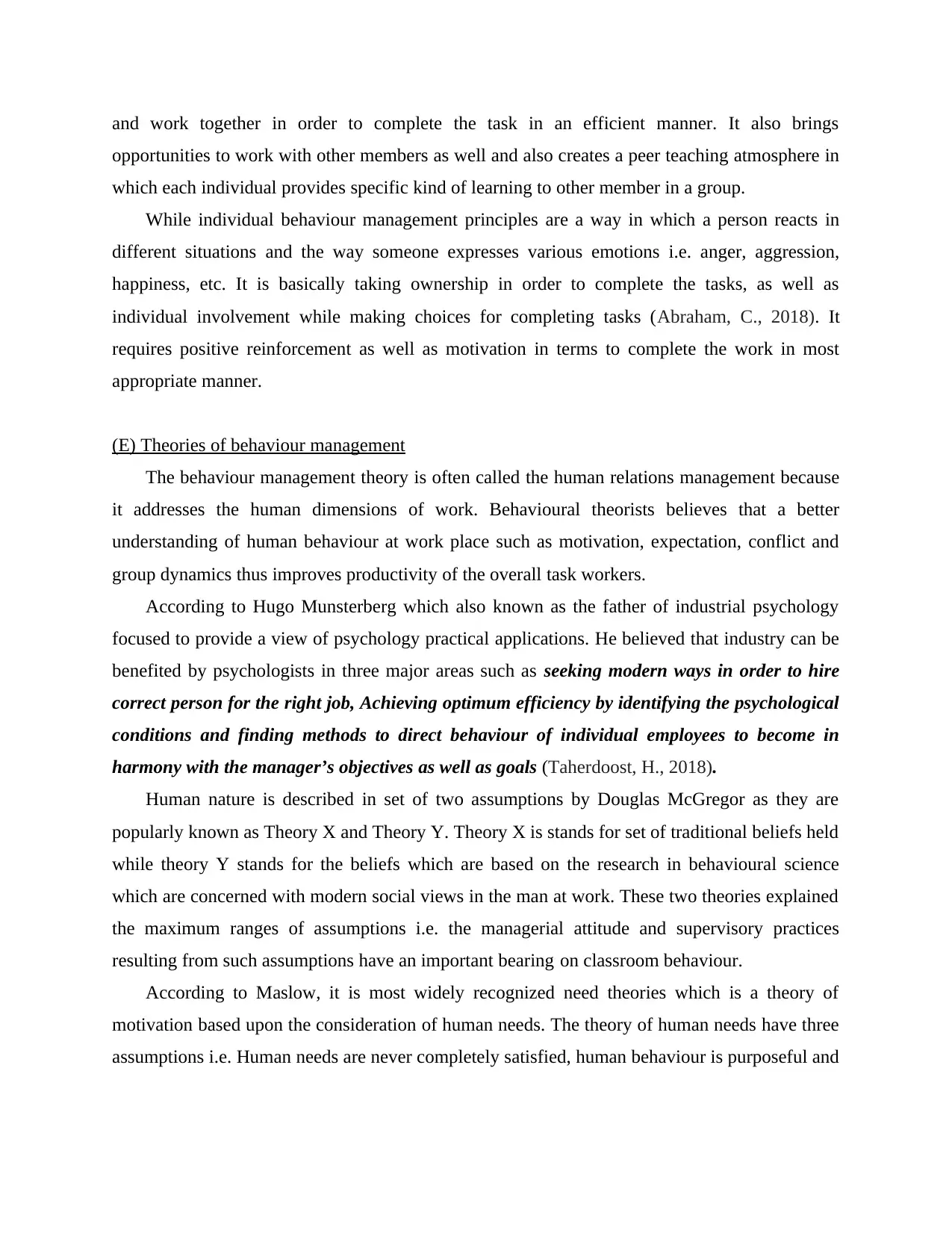
and work together in order to complete the task in an efficient manner. It also brings
opportunities to work with other members as well and also creates a peer teaching atmosphere in
which each individual provides specific kind of learning to other member in a group.
While individual behaviour management principles are a way in which a person reacts in
different situations and the way someone expresses various emotions i.e. anger, aggression,
happiness, etc. It is basically taking ownership in order to complete the tasks, as well as
individual involvement while making choices for completing tasks (Abraham, C., 2018). It
requires positive reinforcement as well as motivation in terms to complete the work in most
appropriate manner.
(E) Theories of behaviour management
The behaviour management theory is often called the human relations management because
it addresses the human dimensions of work. Behavioural theorists believes that a better
understanding of human behaviour at work place such as motivation, expectation, conflict and
group dynamics thus improves productivity of the overall task workers.
According to Hugo Munsterberg which also known as the father of industrial psychology
focused to provide a view of psychology practical applications. He believed that industry can be
benefited by psychologists in three major areas such as seeking modern ways in order to hire
correct person for the right job, Achieving optimum efficiency by identifying the psychological
conditions and finding methods to direct behaviour of individual employees to become in
harmony with the manager’s objectives as well as goals (Taherdoost, H., 2018).
Human nature is described in set of two assumptions by Douglas McGregor as they are
popularly known as Theory X and Theory Y. Theory X is stands for set of traditional beliefs held
while theory Y stands for the beliefs which are based on the research in behavioural science
which are concerned with modern social views in the man at work. These two theories explained
the maximum ranges of assumptions i.e. the managerial attitude and supervisory practices
resulting from such assumptions have an important bearing on classroom behaviour.
According to Maslow, it is most widely recognized need theories which is a theory of
motivation based upon the consideration of human needs. The theory of human needs have three
assumptions i.e. Human needs are never completely satisfied, human behaviour is purposeful and
opportunities to work with other members as well and also creates a peer teaching atmosphere in
which each individual provides specific kind of learning to other member in a group.
While individual behaviour management principles are a way in which a person reacts in
different situations and the way someone expresses various emotions i.e. anger, aggression,
happiness, etc. It is basically taking ownership in order to complete the tasks, as well as
individual involvement while making choices for completing tasks (Abraham, C., 2018). It
requires positive reinforcement as well as motivation in terms to complete the work in most
appropriate manner.
(E) Theories of behaviour management
The behaviour management theory is often called the human relations management because
it addresses the human dimensions of work. Behavioural theorists believes that a better
understanding of human behaviour at work place such as motivation, expectation, conflict and
group dynamics thus improves productivity of the overall task workers.
According to Hugo Munsterberg which also known as the father of industrial psychology
focused to provide a view of psychology practical applications. He believed that industry can be
benefited by psychologists in three major areas such as seeking modern ways in order to hire
correct person for the right job, Achieving optimum efficiency by identifying the psychological
conditions and finding methods to direct behaviour of individual employees to become in
harmony with the manager’s objectives as well as goals (Taherdoost, H., 2018).
Human nature is described in set of two assumptions by Douglas McGregor as they are
popularly known as Theory X and Theory Y. Theory X is stands for set of traditional beliefs held
while theory Y stands for the beliefs which are based on the research in behavioural science
which are concerned with modern social views in the man at work. These two theories explained
the maximum ranges of assumptions i.e. the managerial attitude and supervisory practices
resulting from such assumptions have an important bearing on classroom behaviour.
According to Maslow, it is most widely recognized need theories which is a theory of
motivation based upon the consideration of human needs. The theory of human needs have three
assumptions i.e. Human needs are never completely satisfied, human behaviour is purposeful and
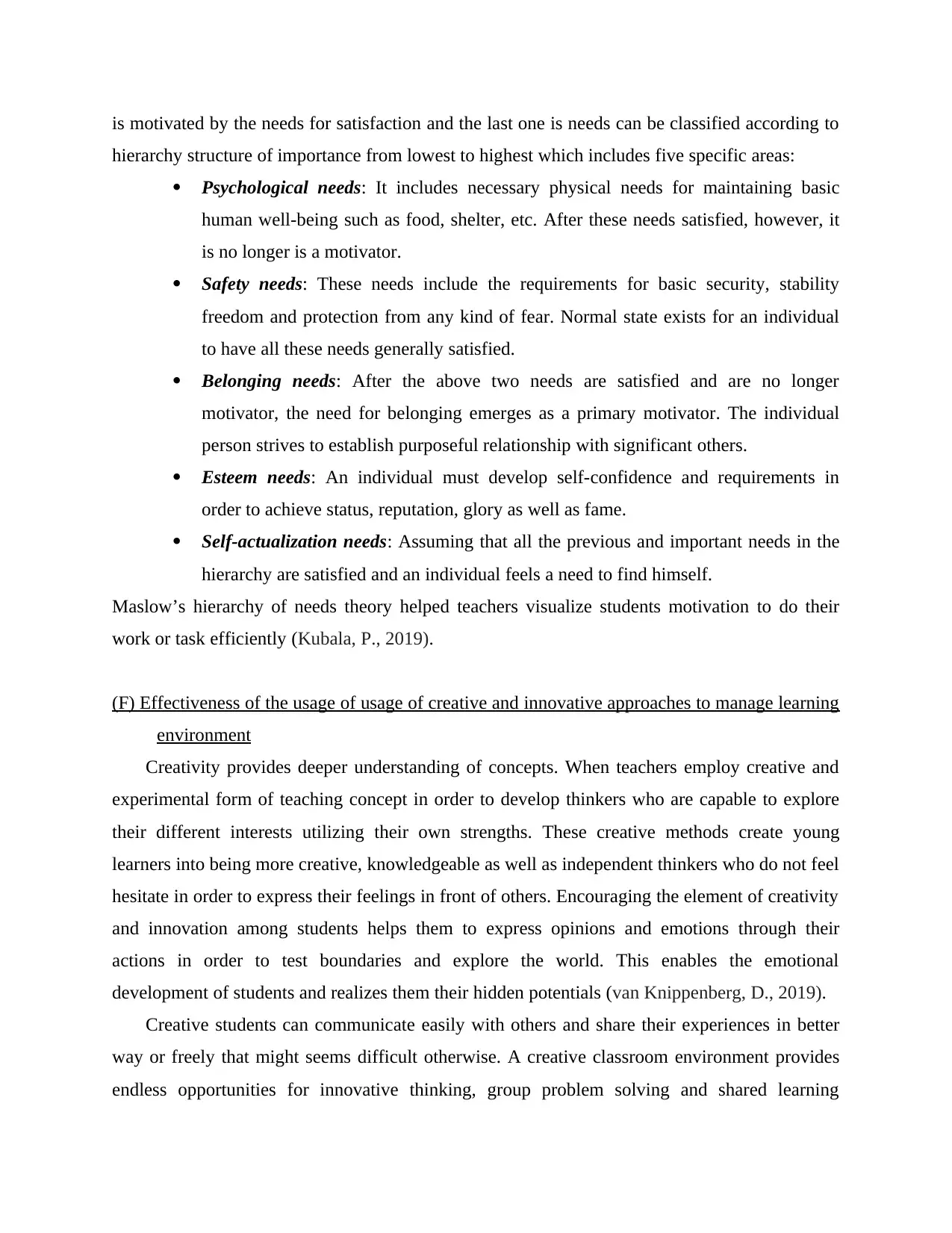
is motivated by the needs for satisfaction and the last one is needs can be classified according to
hierarchy structure of importance from lowest to highest which includes five specific areas:
Psychological needs: It includes necessary physical needs for maintaining basic
human well-being such as food, shelter, etc. After these needs satisfied, however, it
is no longer is a motivator.
Safety needs: These needs include the requirements for basic security, stability
freedom and protection from any kind of fear. Normal state exists for an individual
to have all these needs generally satisfied.
Belonging needs: After the above two needs are satisfied and are no longer
motivator, the need for belonging emerges as a primary motivator. The individual
person strives to establish purposeful relationship with significant others.
Esteem needs: An individual must develop self-confidence and requirements in
order to achieve status, reputation, glory as well as fame.
Self-actualization needs: Assuming that all the previous and important needs in the
hierarchy are satisfied and an individual feels a need to find himself.
Maslow’s hierarchy of needs theory helped teachers visualize students motivation to do their
work or task efficiently (Kubala, P., 2019).
(F) Effectiveness of the usage of usage of creative and innovative approaches to manage learning
environment
Creativity provides deeper understanding of concepts. When teachers employ creative and
experimental form of teaching concept in order to develop thinkers who are capable to explore
their different interests utilizing their own strengths. These creative methods create young
learners into being more creative, knowledgeable as well as independent thinkers who do not feel
hesitate in order to express their feelings in front of others. Encouraging the element of creativity
and innovation among students helps them to express opinions and emotions through their
actions in order to test boundaries and explore the world. This enables the emotional
development of students and realizes them their hidden potentials (van Knippenberg, D., 2019).
Creative students can communicate easily with others and share their experiences in better
way or freely that might seems difficult otherwise. A creative classroom environment provides
endless opportunities for innovative thinking, group problem solving and shared learning
hierarchy structure of importance from lowest to highest which includes five specific areas:
Psychological needs: It includes necessary physical needs for maintaining basic
human well-being such as food, shelter, etc. After these needs satisfied, however, it
is no longer is a motivator.
Safety needs: These needs include the requirements for basic security, stability
freedom and protection from any kind of fear. Normal state exists for an individual
to have all these needs generally satisfied.
Belonging needs: After the above two needs are satisfied and are no longer
motivator, the need for belonging emerges as a primary motivator. The individual
person strives to establish purposeful relationship with significant others.
Esteem needs: An individual must develop self-confidence and requirements in
order to achieve status, reputation, glory as well as fame.
Self-actualization needs: Assuming that all the previous and important needs in the
hierarchy are satisfied and an individual feels a need to find himself.
Maslow’s hierarchy of needs theory helped teachers visualize students motivation to do their
work or task efficiently (Kubala, P., 2019).
(F) Effectiveness of the usage of usage of creative and innovative approaches to manage learning
environment
Creativity provides deeper understanding of concepts. When teachers employ creative and
experimental form of teaching concept in order to develop thinkers who are capable to explore
their different interests utilizing their own strengths. These creative methods create young
learners into being more creative, knowledgeable as well as independent thinkers who do not feel
hesitate in order to express their feelings in front of others. Encouraging the element of creativity
and innovation among students helps them to express opinions and emotions through their
actions in order to test boundaries and explore the world. This enables the emotional
development of students and realizes them their hidden potentials (van Knippenberg, D., 2019).
Creative students can communicate easily with others and share their experiences in better
way or freely that might seems difficult otherwise. A creative classroom environment provides
endless opportunities for innovative thinking, group problem solving and shared learning
Paraphrase This Document
Need a fresh take? Get an instant paraphrase of this document with our AI Paraphraser
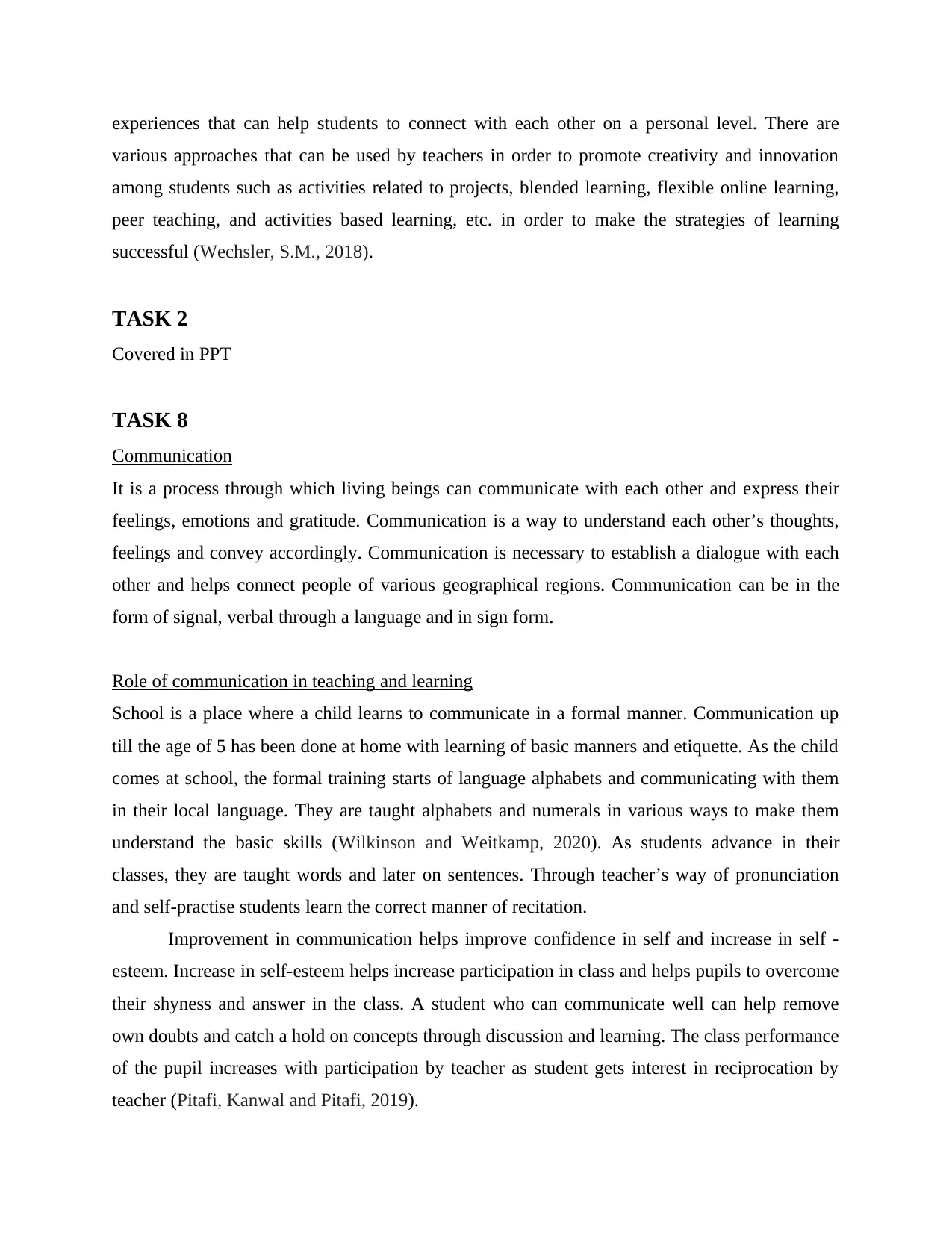
experiences that can help students to connect with each other on a personal level. There are
various approaches that can be used by teachers in order to promote creativity and innovation
among students such as activities related to projects, blended learning, flexible online learning,
peer teaching, and activities based learning, etc. in order to make the strategies of learning
successful (Wechsler, S.M., 2018).
TASK 2
Covered in PPT
TASK 8
Communication
It is a process through which living beings can communicate with each other and express their
feelings, emotions and gratitude. Communication is a way to understand each other’s thoughts,
feelings and convey accordingly. Communication is necessary to establish a dialogue with each
other and helps connect people of various geographical regions. Communication can be in the
form of signal, verbal through a language and in sign form.
Role of communication in teaching and learning
School is a place where a child learns to communicate in a formal manner. Communication up
till the age of 5 has been done at home with learning of basic manners and etiquette. As the child
comes at school, the formal training starts of language alphabets and communicating with them
in their local language. They are taught alphabets and numerals in various ways to make them
understand the basic skills (Wilkinson and Weitkamp, 2020). As students advance in their
classes, they are taught words and later on sentences. Through teacher’s way of pronunciation
and self-practise students learn the correct manner of recitation.
Improvement in communication helps improve confidence in self and increase in self -
esteem. Increase in self-esteem helps increase participation in class and helps pupils to overcome
their shyness and answer in the class. A student who can communicate well can help remove
own doubts and catch a hold on concepts through discussion and learning. The class performance
of the pupil increases with participation by teacher as student gets interest in reciprocation by
teacher (Pitafi, Kanwal and Pitafi, 2019).
various approaches that can be used by teachers in order to promote creativity and innovation
among students such as activities related to projects, blended learning, flexible online learning,
peer teaching, and activities based learning, etc. in order to make the strategies of learning
successful (Wechsler, S.M., 2018).
TASK 2
Covered in PPT
TASK 8
Communication
It is a process through which living beings can communicate with each other and express their
feelings, emotions and gratitude. Communication is a way to understand each other’s thoughts,
feelings and convey accordingly. Communication is necessary to establish a dialogue with each
other and helps connect people of various geographical regions. Communication can be in the
form of signal, verbal through a language and in sign form.
Role of communication in teaching and learning
School is a place where a child learns to communicate in a formal manner. Communication up
till the age of 5 has been done at home with learning of basic manners and etiquette. As the child
comes at school, the formal training starts of language alphabets and communicating with them
in their local language. They are taught alphabets and numerals in various ways to make them
understand the basic skills (Wilkinson and Weitkamp, 2020). As students advance in their
classes, they are taught words and later on sentences. Through teacher’s way of pronunciation
and self-practise students learn the correct manner of recitation.
Improvement in communication helps improve confidence in self and increase in self -
esteem. Increase in self-esteem helps increase participation in class and helps pupils to overcome
their shyness and answer in the class. A student who can communicate well can help remove
own doubts and catch a hold on concepts through discussion and learning. The class performance
of the pupil increases with participation by teacher as student gets interest in reciprocation by
teacher (Pitafi, Kanwal and Pitafi, 2019).
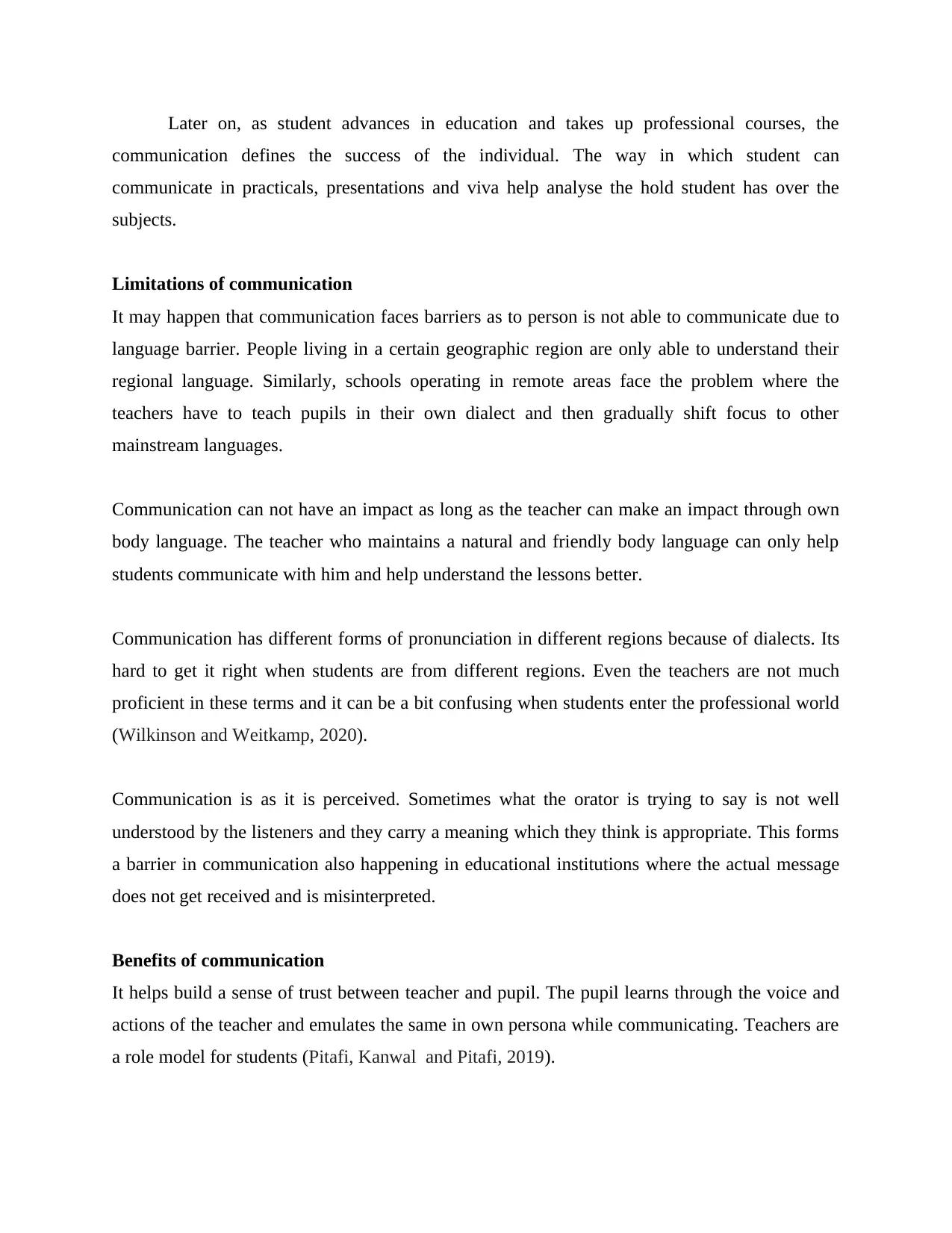
Later on, as student advances in education and takes up professional courses, the
communication defines the success of the individual. The way in which student can
communicate in practicals, presentations and viva help analyse the hold student has over the
subjects.
Limitations of communication
It may happen that communication faces barriers as to person is not able to communicate due to
language barrier. People living in a certain geographic region are only able to understand their
regional language. Similarly, schools operating in remote areas face the problem where the
teachers have to teach pupils in their own dialect and then gradually shift focus to other
mainstream languages.
Communication can not have an impact as long as the teacher can make an impact through own
body language. The teacher who maintains a natural and friendly body language can only help
students communicate with him and help understand the lessons better.
Communication has different forms of pronunciation in different regions because of dialects. Its
hard to get it right when students are from different regions. Even the teachers are not much
proficient in these terms and it can be a bit confusing when students enter the professional world
(Wilkinson and Weitkamp, 2020).
Communication is as it is perceived. Sometimes what the orator is trying to say is not well
understood by the listeners and they carry a meaning which they think is appropriate. This forms
a barrier in communication also happening in educational institutions where the actual message
does not get received and is misinterpreted.
Benefits of communication
It helps build a sense of trust between teacher and pupil. The pupil learns through the voice and
actions of the teacher and emulates the same in own persona while communicating. Teachers are
a role model for students (Pitafi, Kanwal and Pitafi, 2019).
communication defines the success of the individual. The way in which student can
communicate in practicals, presentations and viva help analyse the hold student has over the
subjects.
Limitations of communication
It may happen that communication faces barriers as to person is not able to communicate due to
language barrier. People living in a certain geographic region are only able to understand their
regional language. Similarly, schools operating in remote areas face the problem where the
teachers have to teach pupils in their own dialect and then gradually shift focus to other
mainstream languages.
Communication can not have an impact as long as the teacher can make an impact through own
body language. The teacher who maintains a natural and friendly body language can only help
students communicate with him and help understand the lessons better.
Communication has different forms of pronunciation in different regions because of dialects. Its
hard to get it right when students are from different regions. Even the teachers are not much
proficient in these terms and it can be a bit confusing when students enter the professional world
(Wilkinson and Weitkamp, 2020).
Communication is as it is perceived. Sometimes what the orator is trying to say is not well
understood by the listeners and they carry a meaning which they think is appropriate. This forms
a barrier in communication also happening in educational institutions where the actual message
does not get received and is misinterpreted.
Benefits of communication
It helps build a sense of trust between teacher and pupil. The pupil learns through the voice and
actions of the teacher and emulates the same in own persona while communicating. Teachers are
a role model for students (Pitafi, Kanwal and Pitafi, 2019).
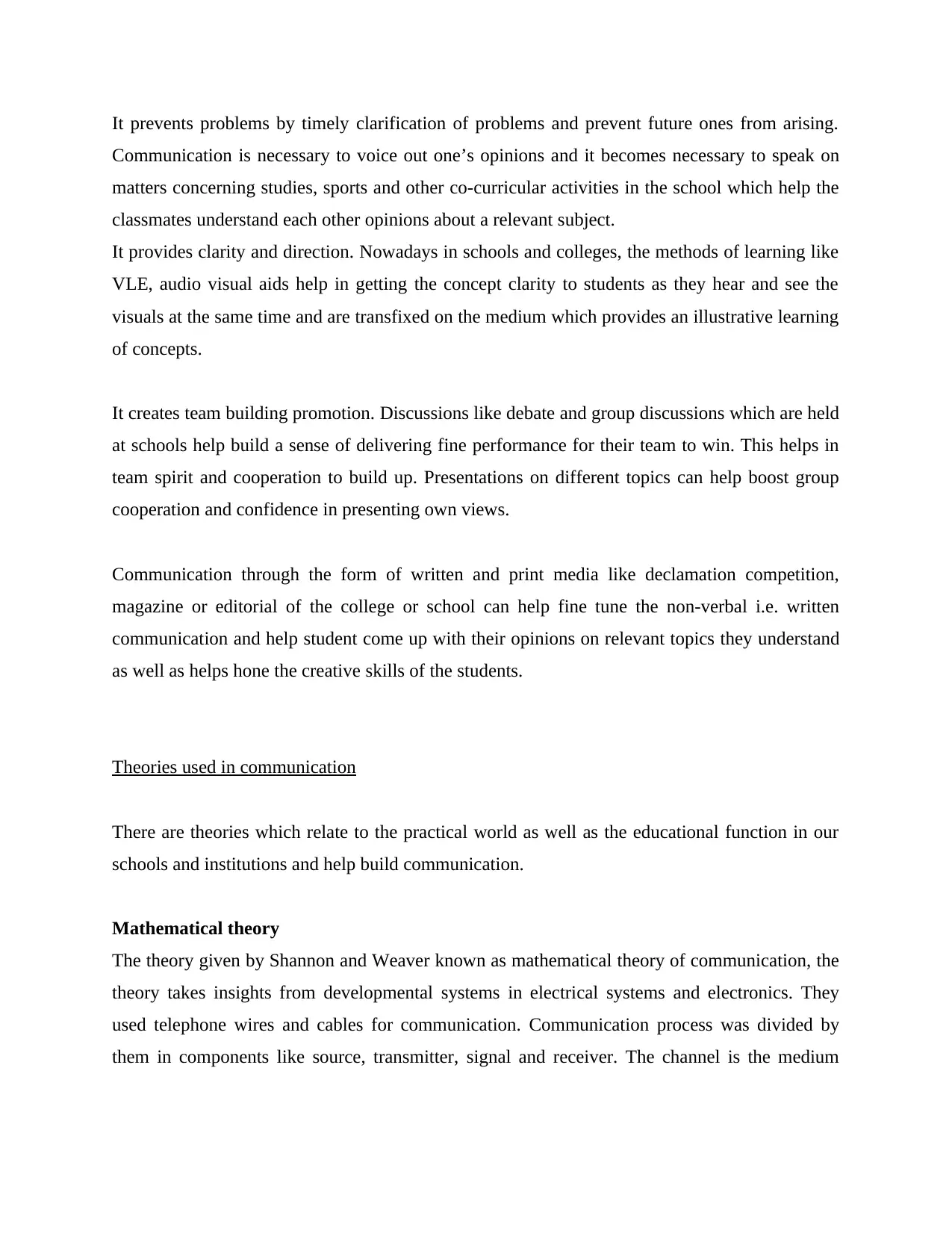
It prevents problems by timely clarification of problems and prevent future ones from arising.
Communication is necessary to voice out one’s opinions and it becomes necessary to speak on
matters concerning studies, sports and other co-curricular activities in the school which help the
classmates understand each other opinions about a relevant subject.
It provides clarity and direction. Nowadays in schools and colleges, the methods of learning like
VLE, audio visual aids help in getting the concept clarity to students as they hear and see the
visuals at the same time and are transfixed on the medium which provides an illustrative learning
of concepts.
It creates team building promotion. Discussions like debate and group discussions which are held
at schools help build a sense of delivering fine performance for their team to win. This helps in
team spirit and cooperation to build up. Presentations on different topics can help boost group
cooperation and confidence in presenting own views.
Communication through the form of written and print media like declamation competition,
magazine or editorial of the college or school can help fine tune the non-verbal i.e. written
communication and help student come up with their opinions on relevant topics they understand
as well as helps hone the creative skills of the students.
Theories used in communication
There are theories which relate to the practical world as well as the educational function in our
schools and institutions and help build communication.
Mathematical theory
The theory given by Shannon and Weaver known as mathematical theory of communication, the
theory takes insights from developmental systems in electrical systems and electronics. They
used telephone wires and cables for communication. Communication process was divided by
them in components like source, transmitter, signal and receiver. The channel is the medium
Communication is necessary to voice out one’s opinions and it becomes necessary to speak on
matters concerning studies, sports and other co-curricular activities in the school which help the
classmates understand each other opinions about a relevant subject.
It provides clarity and direction. Nowadays in schools and colleges, the methods of learning like
VLE, audio visual aids help in getting the concept clarity to students as they hear and see the
visuals at the same time and are transfixed on the medium which provides an illustrative learning
of concepts.
It creates team building promotion. Discussions like debate and group discussions which are held
at schools help build a sense of delivering fine performance for their team to win. This helps in
team spirit and cooperation to build up. Presentations on different topics can help boost group
cooperation and confidence in presenting own views.
Communication through the form of written and print media like declamation competition,
magazine or editorial of the college or school can help fine tune the non-verbal i.e. written
communication and help student come up with their opinions on relevant topics they understand
as well as helps hone the creative skills of the students.
Theories used in communication
There are theories which relate to the practical world as well as the educational function in our
schools and institutions and help build communication.
Mathematical theory
The theory given by Shannon and Weaver known as mathematical theory of communication, the
theory takes insights from developmental systems in electrical systems and electronics. They
used telephone wires and cables for communication. Communication process was divided by
them in components like source, transmitter, signal and receiver. The channel is the medium
Secure Best Marks with AI Grader
Need help grading? Try our AI Grader for instant feedback on your assignments.
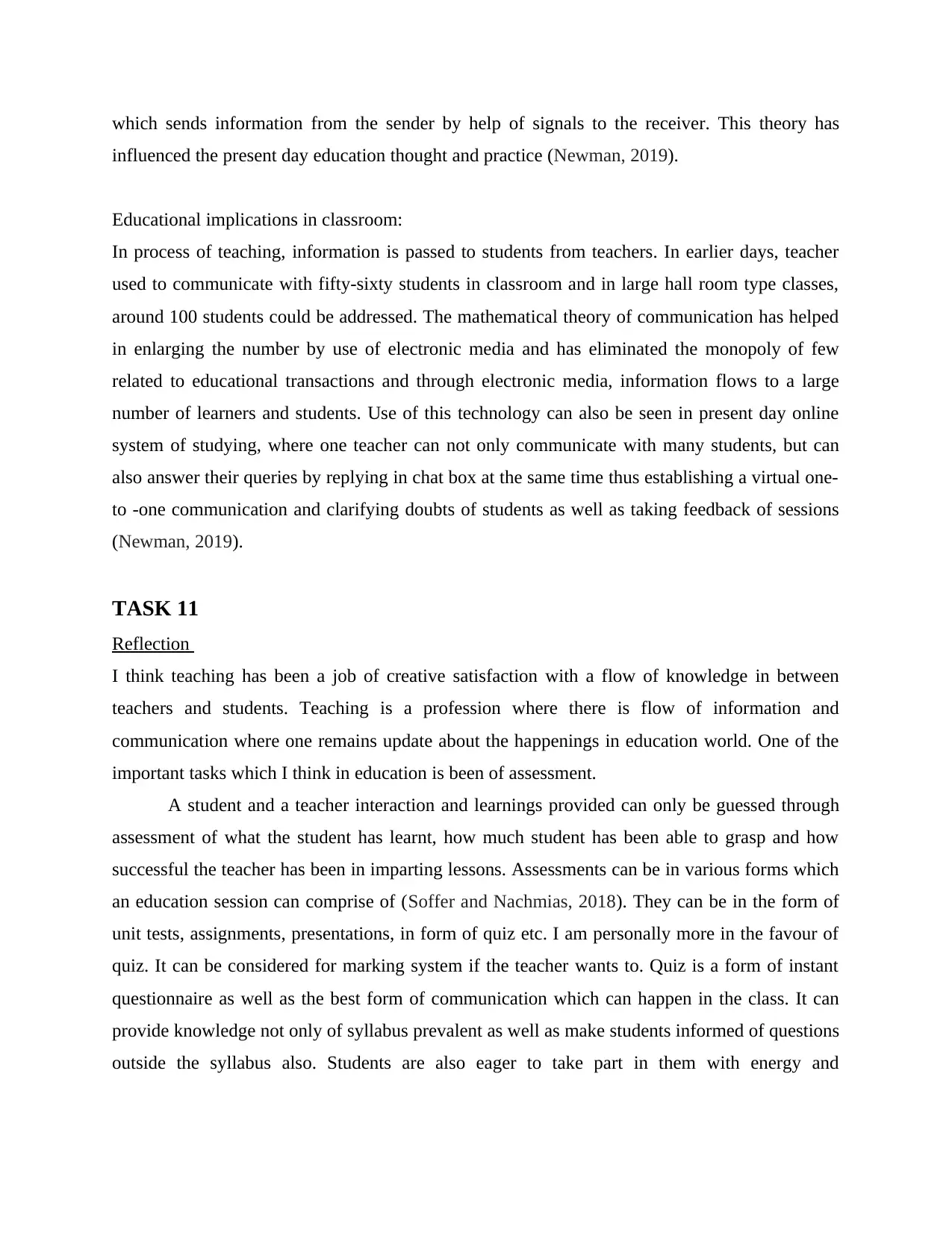
which sends information from the sender by help of signals to the receiver. This theory has
influenced the present day education thought and practice (Newman, 2019).
Educational implications in classroom:
In process of teaching, information is passed to students from teachers. In earlier days, teacher
used to communicate with fifty-sixty students in classroom and in large hall room type classes,
around 100 students could be addressed. The mathematical theory of communication has helped
in enlarging the number by use of electronic media and has eliminated the monopoly of few
related to educational transactions and through electronic media, information flows to a large
number of learners and students. Use of this technology can also be seen in present day online
system of studying, where one teacher can not only communicate with many students, but can
also answer their queries by replying in chat box at the same time thus establishing a virtual one-
to -one communication and clarifying doubts of students as well as taking feedback of sessions
(Newman, 2019).
TASK 11
Reflection
I think teaching has been a job of creative satisfaction with a flow of knowledge in between
teachers and students. Teaching is a profession where there is flow of information and
communication where one remains update about the happenings in education world. One of the
important tasks which I think in education is been of assessment.
A student and a teacher interaction and learnings provided can only be guessed through
assessment of what the student has learnt, how much student has been able to grasp and how
successful the teacher has been in imparting lessons. Assessments can be in various forms which
an education session can comprise of (Soffer and Nachmias, 2018). They can be in the form of
unit tests, assignments, presentations, in form of quiz etc. I am personally more in the favour of
quiz. It can be considered for marking system if the teacher wants to. Quiz is a form of instant
questionnaire as well as the best form of communication which can happen in the class. It can
provide knowledge not only of syllabus prevalent as well as make students informed of questions
outside the syllabus also. Students are also eager to take part in them with energy and
influenced the present day education thought and practice (Newman, 2019).
Educational implications in classroom:
In process of teaching, information is passed to students from teachers. In earlier days, teacher
used to communicate with fifty-sixty students in classroom and in large hall room type classes,
around 100 students could be addressed. The mathematical theory of communication has helped
in enlarging the number by use of electronic media and has eliminated the monopoly of few
related to educational transactions and through electronic media, information flows to a large
number of learners and students. Use of this technology can also be seen in present day online
system of studying, where one teacher can not only communicate with many students, but can
also answer their queries by replying in chat box at the same time thus establishing a virtual one-
to -one communication and clarifying doubts of students as well as taking feedback of sessions
(Newman, 2019).
TASK 11
Reflection
I think teaching has been a job of creative satisfaction with a flow of knowledge in between
teachers and students. Teaching is a profession where there is flow of information and
communication where one remains update about the happenings in education world. One of the
important tasks which I think in education is been of assessment.
A student and a teacher interaction and learnings provided can only be guessed through
assessment of what the student has learnt, how much student has been able to grasp and how
successful the teacher has been in imparting lessons. Assessments can be in various forms which
an education session can comprise of (Soffer and Nachmias, 2018). They can be in the form of
unit tests, assignments, presentations, in form of quiz etc. I am personally more in the favour of
quiz. It can be considered for marking system if the teacher wants to. Quiz is a form of instant
questionnaire as well as the best form of communication which can happen in the class. It can
provide knowledge not only of syllabus prevalent as well as make students informed of questions
outside the syllabus also. Students are also eager to take part in them with energy and
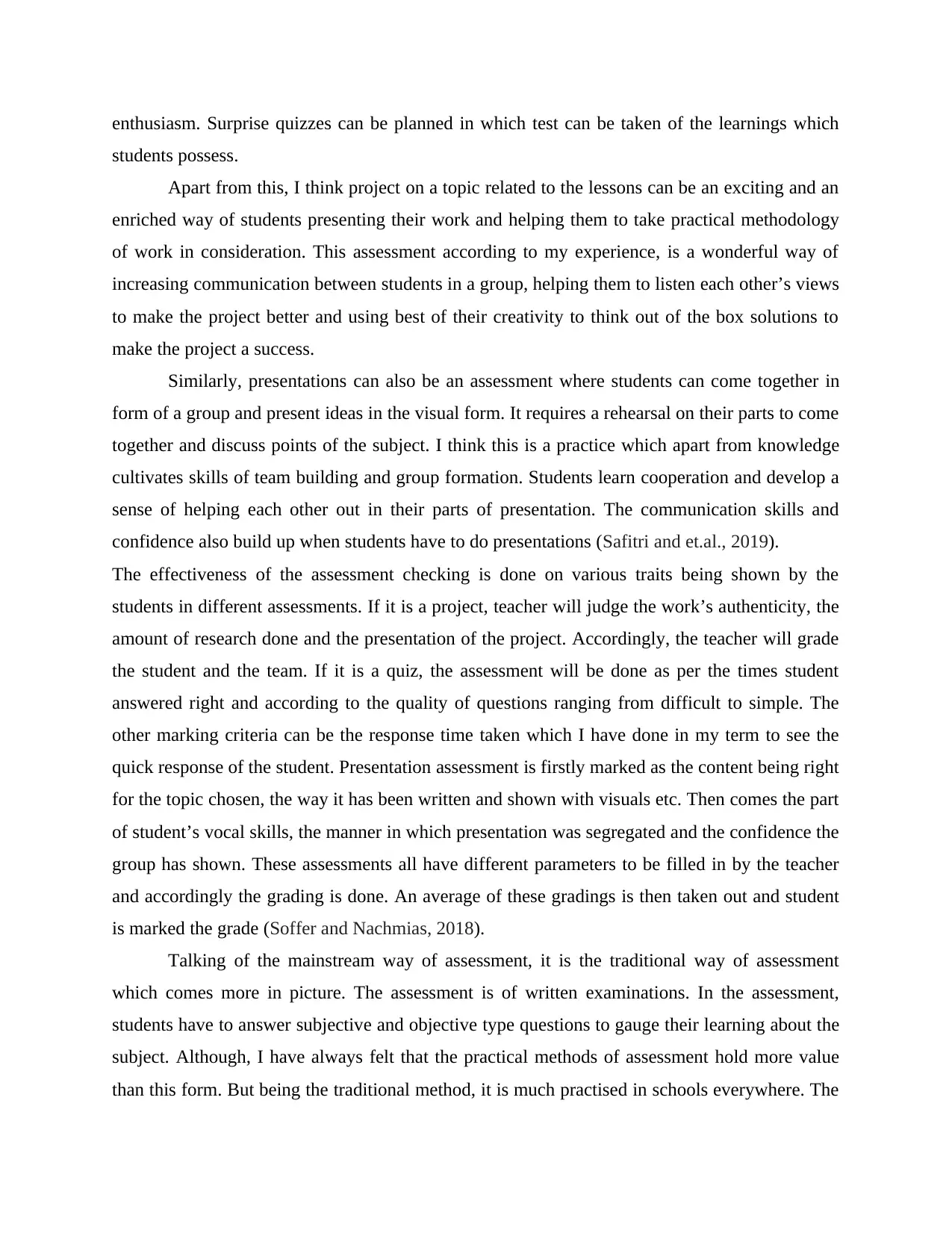
enthusiasm. Surprise quizzes can be planned in which test can be taken of the learnings which
students possess.
Apart from this, I think project on a topic related to the lessons can be an exciting and an
enriched way of students presenting their work and helping them to take practical methodology
of work in consideration. This assessment according to my experience, is a wonderful way of
increasing communication between students in a group, helping them to listen each other’s views
to make the project better and using best of their creativity to think out of the box solutions to
make the project a success.
Similarly, presentations can also be an assessment where students can come together in
form of a group and present ideas in the visual form. It requires a rehearsal on their parts to come
together and discuss points of the subject. I think this is a practice which apart from knowledge
cultivates skills of team building and group formation. Students learn cooperation and develop a
sense of helping each other out in their parts of presentation. The communication skills and
confidence also build up when students have to do presentations (Safitri and et.al., 2019).
The effectiveness of the assessment checking is done on various traits being shown by the
students in different assessments. If it is a project, teacher will judge the work’s authenticity, the
amount of research done and the presentation of the project. Accordingly, the teacher will grade
the student and the team. If it is a quiz, the assessment will be done as per the times student
answered right and according to the quality of questions ranging from difficult to simple. The
other marking criteria can be the response time taken which I have done in my term to see the
quick response of the student. Presentation assessment is firstly marked as the content being right
for the topic chosen, the way it has been written and shown with visuals etc. Then comes the part
of student’s vocal skills, the manner in which presentation was segregated and the confidence the
group has shown. These assessments all have different parameters to be filled in by the teacher
and accordingly the grading is done. An average of these gradings is then taken out and student
is marked the grade (Soffer and Nachmias, 2018).
Talking of the mainstream way of assessment, it is the traditional way of assessment
which comes more in picture. The assessment is of written examinations. In the assessment,
students have to answer subjective and objective type questions to gauge their learning about the
subject. Although, I have always felt that the practical methods of assessment hold more value
than this form. But being the traditional method, it is much practised in schools everywhere. The
students possess.
Apart from this, I think project on a topic related to the lessons can be an exciting and an
enriched way of students presenting their work and helping them to take practical methodology
of work in consideration. This assessment according to my experience, is a wonderful way of
increasing communication between students in a group, helping them to listen each other’s views
to make the project better and using best of their creativity to think out of the box solutions to
make the project a success.
Similarly, presentations can also be an assessment where students can come together in
form of a group and present ideas in the visual form. It requires a rehearsal on their parts to come
together and discuss points of the subject. I think this is a practice which apart from knowledge
cultivates skills of team building and group formation. Students learn cooperation and develop a
sense of helping each other out in their parts of presentation. The communication skills and
confidence also build up when students have to do presentations (Safitri and et.al., 2019).
The effectiveness of the assessment checking is done on various traits being shown by the
students in different assessments. If it is a project, teacher will judge the work’s authenticity, the
amount of research done and the presentation of the project. Accordingly, the teacher will grade
the student and the team. If it is a quiz, the assessment will be done as per the times student
answered right and according to the quality of questions ranging from difficult to simple. The
other marking criteria can be the response time taken which I have done in my term to see the
quick response of the student. Presentation assessment is firstly marked as the content being right
for the topic chosen, the way it has been written and shown with visuals etc. Then comes the part
of student’s vocal skills, the manner in which presentation was segregated and the confidence the
group has shown. These assessments all have different parameters to be filled in by the teacher
and accordingly the grading is done. An average of these gradings is then taken out and student
is marked the grade (Soffer and Nachmias, 2018).
Talking of the mainstream way of assessment, it is the traditional way of assessment
which comes more in picture. The assessment is of written examinations. In the assessment,
students have to answer subjective and objective type questions to gauge their learning about the
subject. Although, I have always felt that the practical methods of assessment hold more value
than this form. But being the traditional method, it is much practised in schools everywhere. The
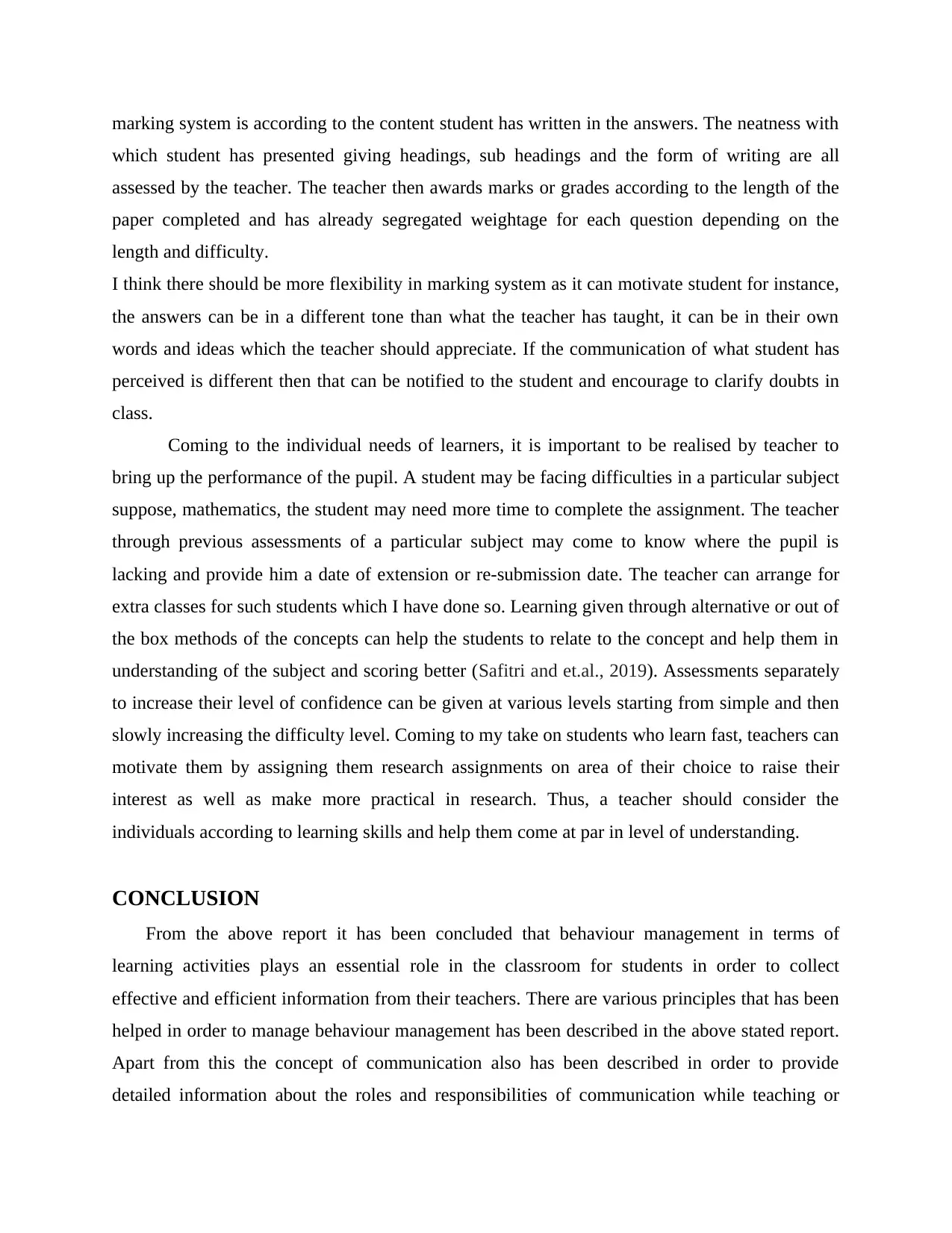
marking system is according to the content student has written in the answers. The neatness with
which student has presented giving headings, sub headings and the form of writing are all
assessed by the teacher. The teacher then awards marks or grades according to the length of the
paper completed and has already segregated weightage for each question depending on the
length and difficulty.
I think there should be more flexibility in marking system as it can motivate student for instance,
the answers can be in a different tone than what the teacher has taught, it can be in their own
words and ideas which the teacher should appreciate. If the communication of what student has
perceived is different then that can be notified to the student and encourage to clarify doubts in
class.
Coming to the individual needs of learners, it is important to be realised by teacher to
bring up the performance of the pupil. A student may be facing difficulties in a particular subject
suppose, mathematics, the student may need more time to complete the assignment. The teacher
through previous assessments of a particular subject may come to know where the pupil is
lacking and provide him a date of extension or re-submission date. The teacher can arrange for
extra classes for such students which I have done so. Learning given through alternative or out of
the box methods of the concepts can help the students to relate to the concept and help them in
understanding of the subject and scoring better (Safitri and et.al., 2019). Assessments separately
to increase their level of confidence can be given at various levels starting from simple and then
slowly increasing the difficulty level. Coming to my take on students who learn fast, teachers can
motivate them by assigning them research assignments on area of their choice to raise their
interest as well as make more practical in research. Thus, a teacher should consider the
individuals according to learning skills and help them come at par in level of understanding.
CONCLUSION
From the above report it has been concluded that behaviour management in terms of
learning activities plays an essential role in the classroom for students in order to collect
effective and efficient information from their teachers. There are various principles that has been
helped in order to manage behaviour management has been described in the above stated report.
Apart from this the concept of communication also has been described in order to provide
detailed information about the roles and responsibilities of communication while teaching or
which student has presented giving headings, sub headings and the form of writing are all
assessed by the teacher. The teacher then awards marks or grades according to the length of the
paper completed and has already segregated weightage for each question depending on the
length and difficulty.
I think there should be more flexibility in marking system as it can motivate student for instance,
the answers can be in a different tone than what the teacher has taught, it can be in their own
words and ideas which the teacher should appreciate. If the communication of what student has
perceived is different then that can be notified to the student and encourage to clarify doubts in
class.
Coming to the individual needs of learners, it is important to be realised by teacher to
bring up the performance of the pupil. A student may be facing difficulties in a particular subject
suppose, mathematics, the student may need more time to complete the assignment. The teacher
through previous assessments of a particular subject may come to know where the pupil is
lacking and provide him a date of extension or re-submission date. The teacher can arrange for
extra classes for such students which I have done so. Learning given through alternative or out of
the box methods of the concepts can help the students to relate to the concept and help them in
understanding of the subject and scoring better (Safitri and et.al., 2019). Assessments separately
to increase their level of confidence can be given at various levels starting from simple and then
slowly increasing the difficulty level. Coming to my take on students who learn fast, teachers can
motivate them by assigning them research assignments on area of their choice to raise their
interest as well as make more practical in research. Thus, a teacher should consider the
individuals according to learning skills and help them come at par in level of understanding.
CONCLUSION
From the above report it has been concluded that behaviour management in terms of
learning activities plays an essential role in the classroom for students in order to collect
effective and efficient information from their teachers. There are various principles that has been
helped in order to manage behaviour management has been described in the above stated report.
Apart from this the concept of communication also has been described in order to provide
detailed information about the roles and responsibilities of communication while teaching or
Paraphrase This Document
Need a fresh take? Get an instant paraphrase of this document with our AI Paraphraser
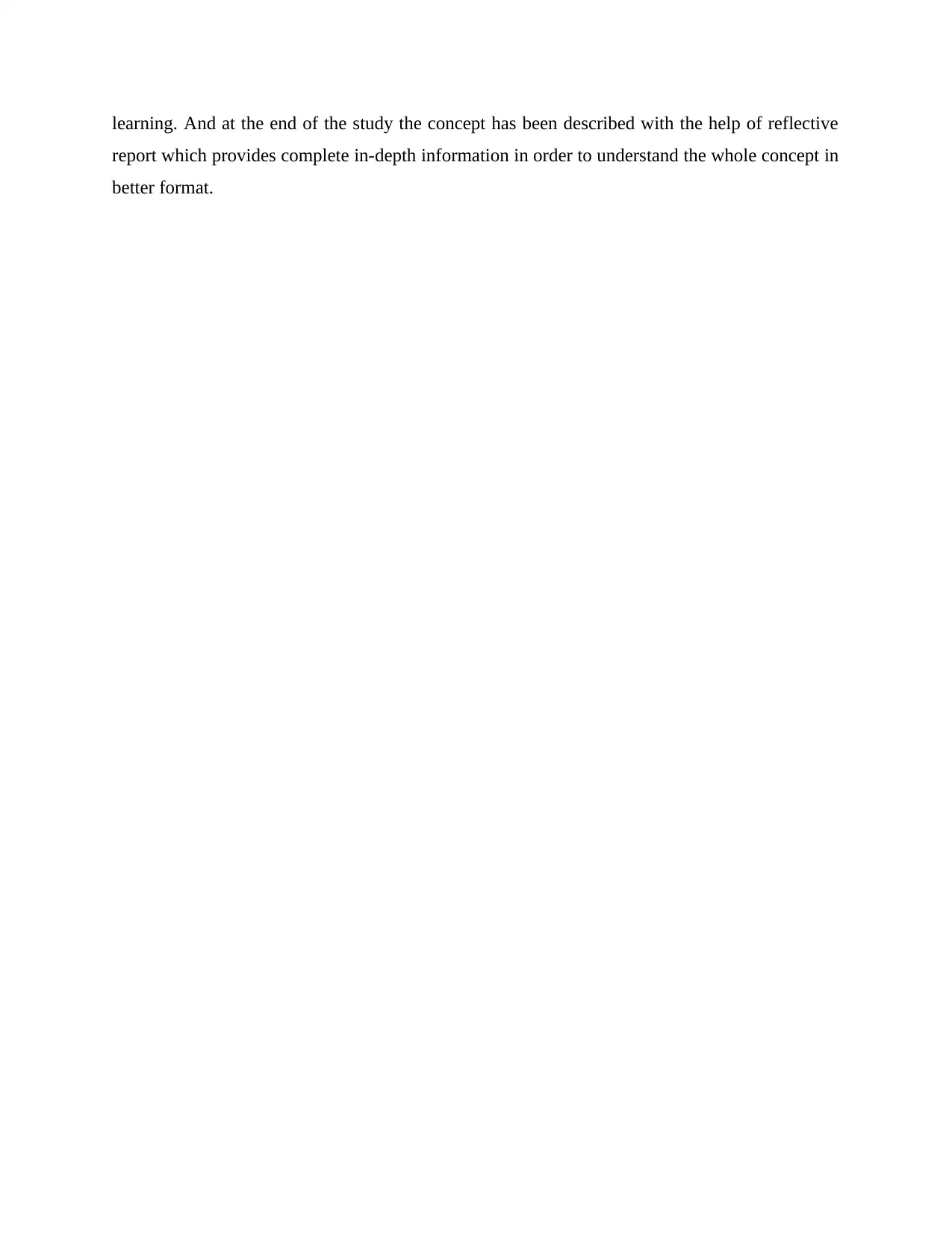
learning. And at the end of the study the concept has been described with the help of reflective
report which provides complete in-depth information in order to understand the whole concept in
better format.
report which provides complete in-depth information in order to understand the whole concept in
better format.
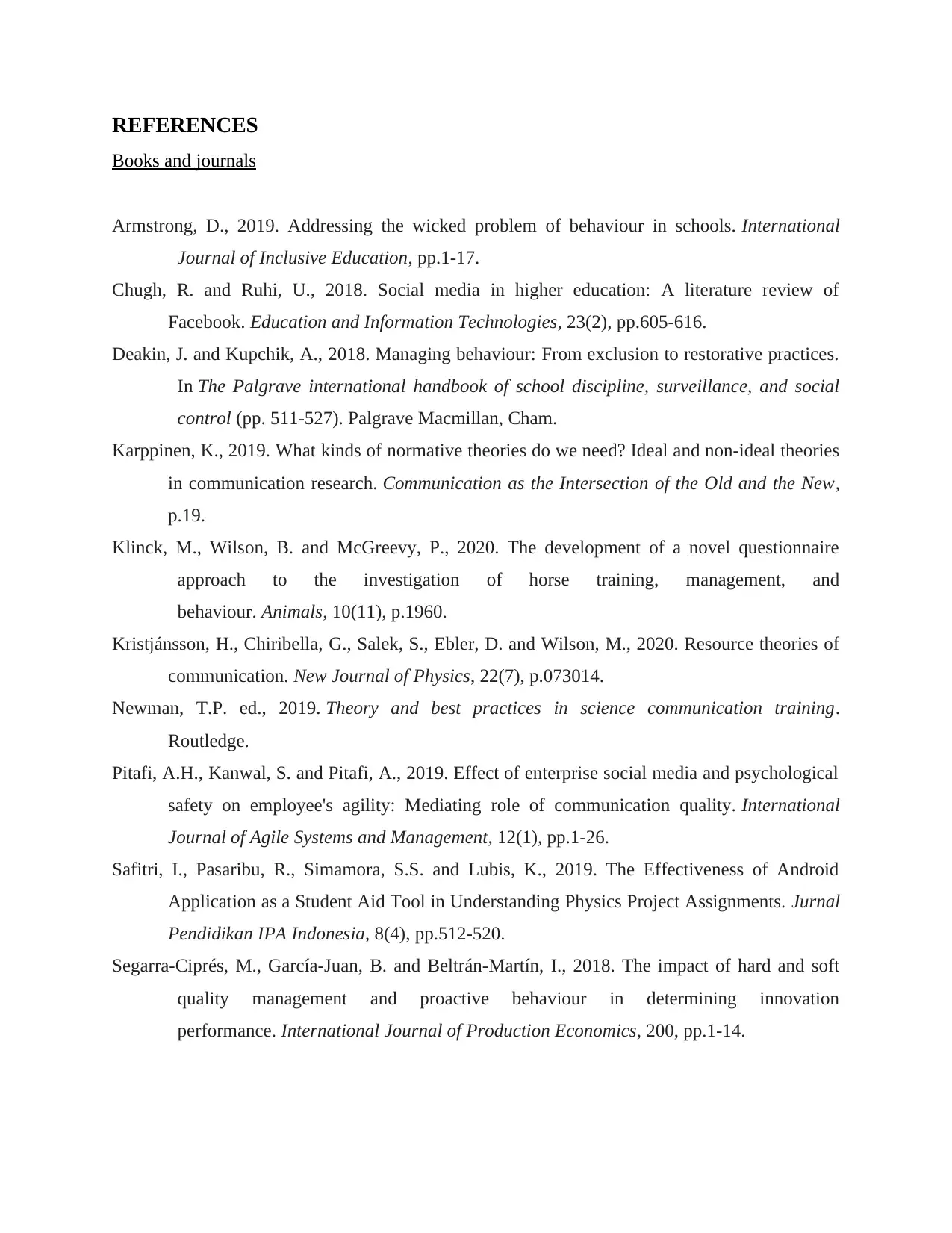
REFERENCES
Books and journals
Armstrong, D., 2019. Addressing the wicked problem of behaviour in schools. International
Journal of Inclusive Education, pp.1-17.
Chugh, R. and Ruhi, U., 2018. Social media in higher education: A literature review of
Facebook. Education and Information Technologies, 23(2), pp.605-616.
Deakin, J. and Kupchik, A., 2018. Managing behaviour: From exclusion to restorative practices.
In The Palgrave international handbook of school discipline, surveillance, and social
control (pp. 511-527). Palgrave Macmillan, Cham.
Karppinen, K., 2019. What kinds of normative theories do we need? Ideal and non-ideal theories
in communication research. Communication as the Intersection of the Old and the New,
p.19.
Klinck, M., Wilson, B. and McGreevy, P., 2020. The development of a novel questionnaire
approach to the investigation of horse training, management, and
behaviour. Animals, 10(11), p.1960.
Kristjánsson, H., Chiribella, G., Salek, S., Ebler, D. and Wilson, M., 2020. Resource theories of
communication. New Journal of Physics, 22(7), p.073014.
Newman, T.P. ed., 2019. Theory and best practices in science communication training.
Routledge.
Pitafi, A.H., Kanwal, S. and Pitafi, A., 2019. Effect of enterprise social media and psychological
safety on employee's agility: Mediating role of communication quality. International
Journal of Agile Systems and Management, 12(1), pp.1-26.
Safitri, I., Pasaribu, R., Simamora, S.S. and Lubis, K., 2019. The Effectiveness of Android
Application as a Student Aid Tool in Understanding Physics Project Assignments. Jurnal
Pendidikan IPA Indonesia, 8(4), pp.512-520.
Segarra-Ciprés, M., García-Juan, B. and Beltrán-Martín, I., 2018. The impact of hard and soft
quality management and proactive behaviour in determining innovation
performance. International Journal of Production Economics, 200, pp.1-14.
Books and journals
Armstrong, D., 2019. Addressing the wicked problem of behaviour in schools. International
Journal of Inclusive Education, pp.1-17.
Chugh, R. and Ruhi, U., 2018. Social media in higher education: A literature review of
Facebook. Education and Information Technologies, 23(2), pp.605-616.
Deakin, J. and Kupchik, A., 2018. Managing behaviour: From exclusion to restorative practices.
In The Palgrave international handbook of school discipline, surveillance, and social
control (pp. 511-527). Palgrave Macmillan, Cham.
Karppinen, K., 2019. What kinds of normative theories do we need? Ideal and non-ideal theories
in communication research. Communication as the Intersection of the Old and the New,
p.19.
Klinck, M., Wilson, B. and McGreevy, P., 2020. The development of a novel questionnaire
approach to the investigation of horse training, management, and
behaviour. Animals, 10(11), p.1960.
Kristjánsson, H., Chiribella, G., Salek, S., Ebler, D. and Wilson, M., 2020. Resource theories of
communication. New Journal of Physics, 22(7), p.073014.
Newman, T.P. ed., 2019. Theory and best practices in science communication training.
Routledge.
Pitafi, A.H., Kanwal, S. and Pitafi, A., 2019. Effect of enterprise social media and psychological
safety on employee's agility: Mediating role of communication quality. International
Journal of Agile Systems and Management, 12(1), pp.1-26.
Safitri, I., Pasaribu, R., Simamora, S.S. and Lubis, K., 2019. The Effectiveness of Android
Application as a Student Aid Tool in Understanding Physics Project Assignments. Jurnal
Pendidikan IPA Indonesia, 8(4), pp.512-520.
Segarra-Ciprés, M., García-Juan, B. and Beltrán-Martín, I., 2018. The impact of hard and soft
quality management and proactive behaviour in determining innovation
performance. International Journal of Production Economics, 200, pp.1-14.
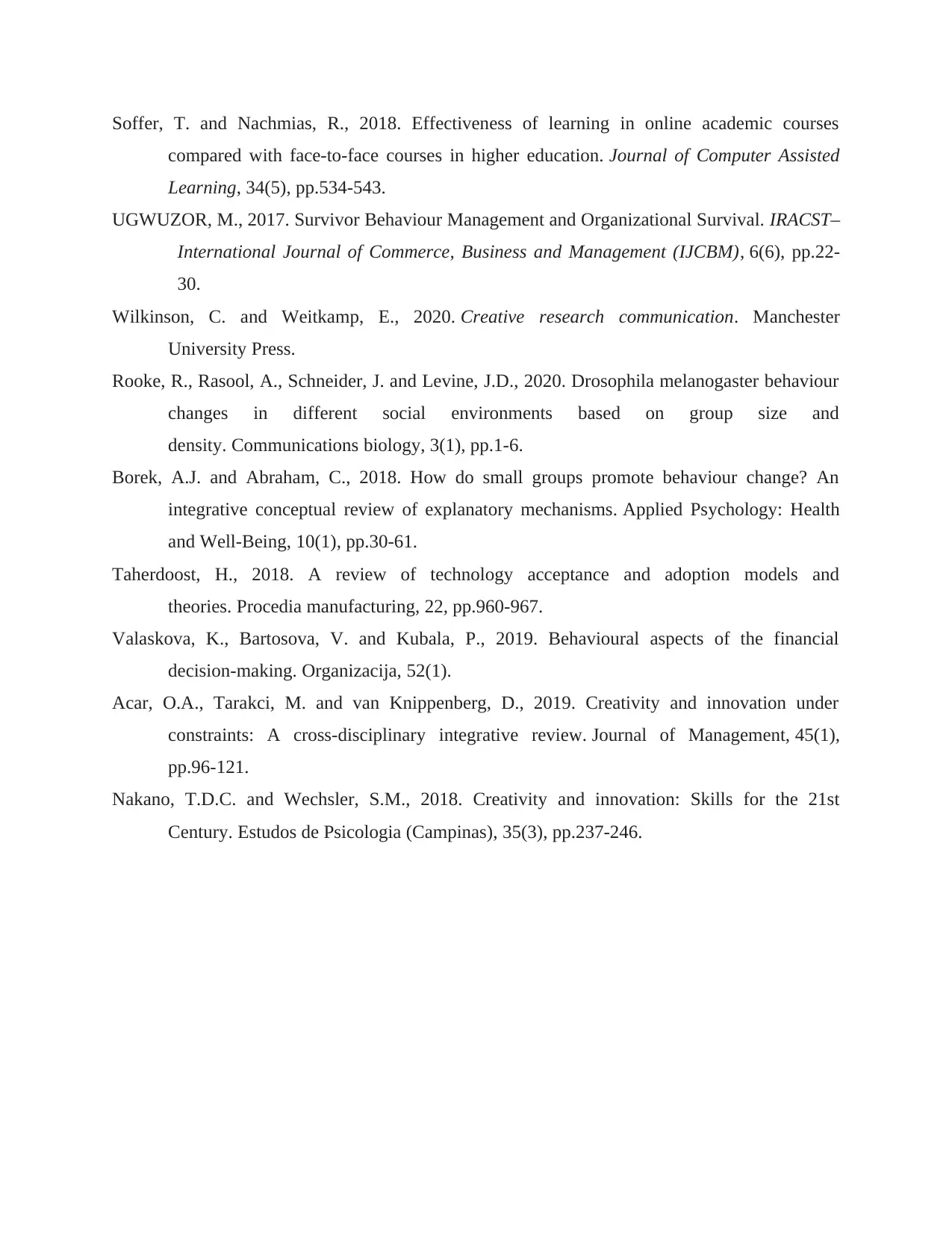
Soffer, T. and Nachmias, R., 2018. Effectiveness of learning in online academic courses
compared with face‐to‐face courses in higher education. Journal of Computer Assisted
Learning, 34(5), pp.534-543.
UGWUZOR, M., 2017. Survivor Behaviour Management and Organizational Survival. IRACST–
International Journal of Commerce, Business and Management (IJCBM), 6(6), pp.22-
30.
Wilkinson, C. and Weitkamp, E., 2020. Creative research communication. Manchester
University Press.
Rooke, R., Rasool, A., Schneider, J. and Levine, J.D., 2020. Drosophila melanogaster behaviour
changes in different social environments based on group size and
density. Communications biology, 3(1), pp.1-6.
Borek, A.J. and Abraham, C., 2018. How do small groups promote behaviour change? An
integrative conceptual review of explanatory mechanisms. Applied Psychology: Health
and Well‐Being, 10(1), pp.30-61.
Taherdoost, H., 2018. A review of technology acceptance and adoption models and
theories. Procedia manufacturing, 22, pp.960-967.
Valaskova, K., Bartosova, V. and Kubala, P., 2019. Behavioural aspects of the financial
decision-making. Organizacija, 52(1).
Acar, O.A., Tarakci, M. and van Knippenberg, D., 2019. Creativity and innovation under
constraints: A cross-disciplinary integrative review. Journal of Management, 45(1),
pp.96-121.
Nakano, T.D.C. and Wechsler, S.M., 2018. Creativity and innovation: Skills for the 21st
Century. Estudos de Psicologia (Campinas), 35(3), pp.237-246.
compared with face‐to‐face courses in higher education. Journal of Computer Assisted
Learning, 34(5), pp.534-543.
UGWUZOR, M., 2017. Survivor Behaviour Management and Organizational Survival. IRACST–
International Journal of Commerce, Business and Management (IJCBM), 6(6), pp.22-
30.
Wilkinson, C. and Weitkamp, E., 2020. Creative research communication. Manchester
University Press.
Rooke, R., Rasool, A., Schneider, J. and Levine, J.D., 2020. Drosophila melanogaster behaviour
changes in different social environments based on group size and
density. Communications biology, 3(1), pp.1-6.
Borek, A.J. and Abraham, C., 2018. How do small groups promote behaviour change? An
integrative conceptual review of explanatory mechanisms. Applied Psychology: Health
and Well‐Being, 10(1), pp.30-61.
Taherdoost, H., 2018. A review of technology acceptance and adoption models and
theories. Procedia manufacturing, 22, pp.960-967.
Valaskova, K., Bartosova, V. and Kubala, P., 2019. Behavioural aspects of the financial
decision-making. Organizacija, 52(1).
Acar, O.A., Tarakci, M. and van Knippenberg, D., 2019. Creativity and innovation under
constraints: A cross-disciplinary integrative review. Journal of Management, 45(1),
pp.96-121.
Nakano, T.D.C. and Wechsler, S.M., 2018. Creativity and innovation: Skills for the 21st
Century. Estudos de Psicologia (Campinas), 35(3), pp.237-246.
Secure Best Marks with AI Grader
Need help grading? Try our AI Grader for instant feedback on your assignments.

1
1 out of 17
Related Documents
Your All-in-One AI-Powered Toolkit for Academic Success.
+13062052269
info@desklib.com
Available 24*7 on WhatsApp / Email
![[object Object]](/_next/static/media/star-bottom.7253800d.svg)
Unlock your academic potential
© 2024 | Zucol Services PVT LTD | All rights reserved.





